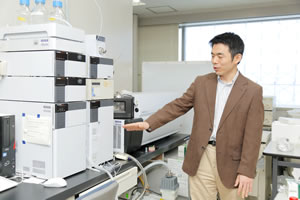- HOME
- Wow! Cool Laboratory [Researcher Introduction]
- Ken’ichiro Matsumoto
Wow! Cool Laboratory [Researcher Introduction]

Division of Applied Chemistry,
Research Group of Biotechnology,
Laboratory of Biomolecular Engineering
Field of research: molecular biology, polymer chemistry
Research theme: Synthesis of useful substances using biological systems
E-mail: mken[a]eng.hokudai.ac.jp
Polymerization of glycolic acid inside the microbial cells
The first report of biosynthesis of glycolate-based polymer using an engineered enzyme
The Laboratory of Biomolecular Engineering is involved in research based on molecular biology techniques. The main focus of research is on the development of a synthesis system for bioplastics using microorganisms and plants.
“Certain types of microorganisms have the nature to synthesize polyesters and accumulate them within their cells. As we have expanded this ability artificially, we have discovered that microbes are able to synthesize various polyesters, that are not naturally synthesized. Among these, we are focusing on research of glycolate-based polymers,” said Associate Professor Ken’ichiro Matsumoto.
Glycolate-based polymer, which is used in the medical field, has the nature to be degraded inside an organism. Glycolate-based polymer is synthesized by catalytic polymerization of glycolic acid. Since it is used in the body, the possibility of a residual catalyst is a big problem, and it is costly to remove it. If this polymer can be produced by biosynthesis, it will not contain chemical elements that are not utilized by organisms. Therefore, I thought it would have added-value as a material.”
The key to realizing this technology was an engineered enzyme, which was also developed at the Laboratory of Biomolecular Engineering. Natural polyester polymerases polymerize monomers, which have a hydroxy group in the third position, such as 3-hydroxybutyric acid. Professor Seiichi Taguchi, the head of the laboratory, was the first to have success with the polymerization of a lactic acid with a 2-hydroxy group based on research of polymerase mutants, and received much attention (note 1). Matsumoto thought that another molecule could be polymerized using the modified polymerase, and tried to synthesize a structural analog – glycolic acid polymer.
“We failed repeatedly and couldn’t create polymers at all when we started with the experiment. Laboratory members started saying that the enzyme does not have polymerization activity for glycolic acid. However, I thoroughly reviewed the experimental conditions and noticed that we have not done enough experiments to conclude that the enzyme has no polymerization activity. I shared my idea with a student who was involved in the experiment at the time, and she was motivated to try many different synthesis conditions. Based on the results of her research, we could eventually find the conditions for polymerization.”
However, at this stage, microorganisms are used only during the polymerization process and petroleum-based glycolic acid is externally added to the medium. Matsumoto has future plans to develop a biosynthesis method to produce glycolic acid polymers from naturally derived sugars.
“For example, a large volume of cellulose and hemicelluloses are contained in trees and leaves. These are mainly glucose compounds, and research and development of technologies to extract sugars from plants are widely conducted. The process is not our focus of research; however, the sugars can be used to biosynthesize glycolic acid polymers. If such technology is realized, valuable products can be produced from reasonable resources that are abundant on the earth. It will be groundbreaking technology that can be utilized in many different fields.”
A soft, processable polymer
Expected to be commercialized in a variety of fields
Matsumoto is now analyzing the physical properties of the biosynthesized glycolate-based polymer films.
“We can create superior films from the biosynthesized glycolate-based polymer that are semi-transparent and very soft. I think these films can be used as a material in some way (photo 1). The expected characteristics of this film include (1) a flexible material due to its soft, pliable property and (2) the possibility of changing the degradation rate by adjusting the percentage of the glycolate units contained in the polymer. Since we are still at a stage of basic analysis of the physical properties, we cannot tell exactly how far we can go to realize these characteristics. However, I know we can have high expectations of the possibilities.”
The laboratory is involved in the analysis of monomer molecules, which are the building blocks of the polymers found in cells, using a device that measures the mass of samples separated by liquid chromatography (photo 2).
“We are analyzing what biosynthesis processes are involved by modifying the genes of microorganisms, but things often do not go as expected. It is necessary to confirm the metabolic processes occurring within the cells. We hope that we will be able to clarify metabolism and polymerization mechanisms through analysis using these devices.”
The biosynthesis of glycolate-based polymer is a new technology, and many elements of its physical properties and processing methods have not been identified. The production costs are also high. There are many barriers to overcome. However, Matsumoto sees great potential in glycolate-based polymer as a new material to replace petroleum-based polyester products.
“This material is easy to process, versatile, and even highly degradable. I expect this material can show its potential in a variety of fields. I hope that the material will attract the attention of many companies, and that we can collaborate with them using innovative ideas.”
| Note 1 | First ever success in the world: one-step synthesis of bioplastic using modified coli bacteria with lactate-polymerizing enzyme |
|---|

Photo 1. The film

Photo 2. Equipment
A liquid chromatography and mass spectroscopy that was recently installed in the laboratory. These detect and identify extremely small amount of constituents of complicated mixtures (e.g., metabolic intermediates in cells).
